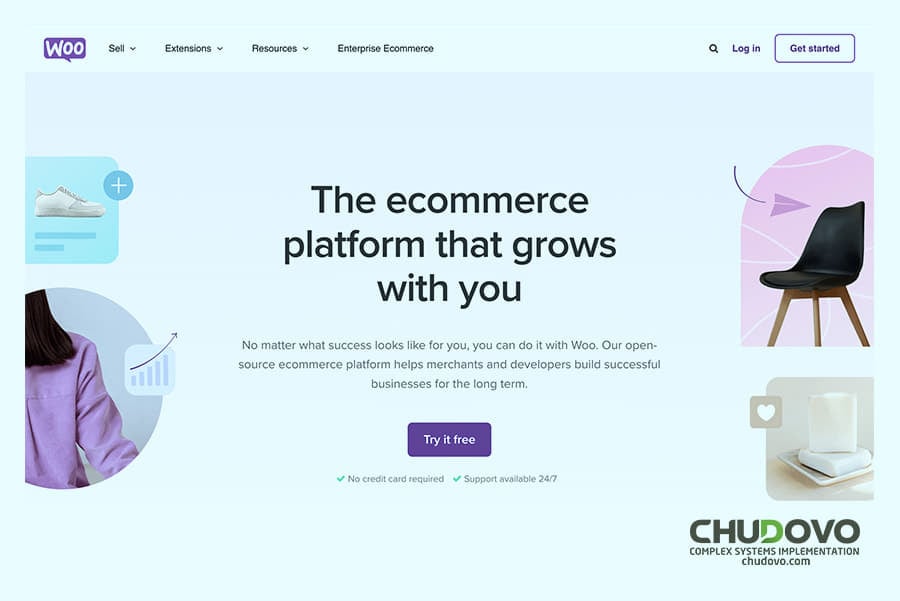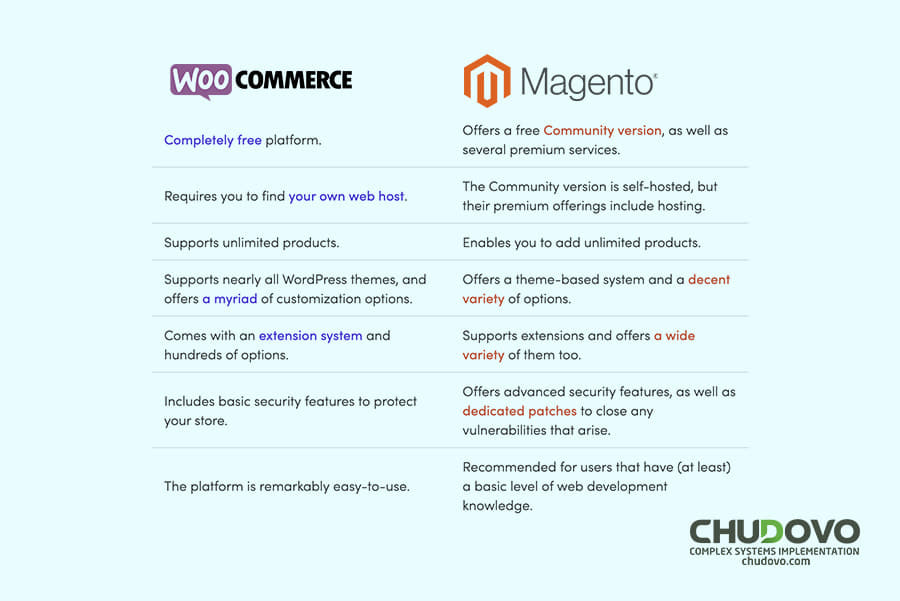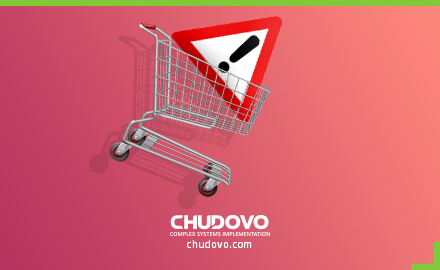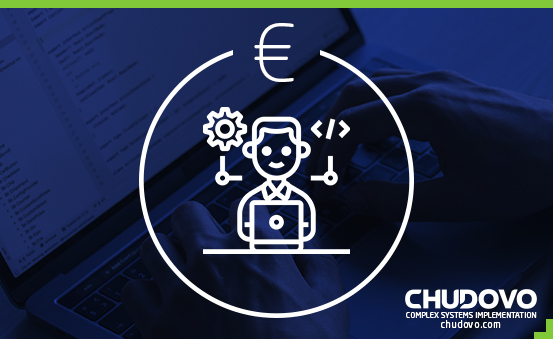Battle of the E-commerce Titans: Magento vs Woocommerce
Navigating the vast maze of online commerce can sometimes feel like stepping into a battle. The heart of this conflict often revolves around choosing the perfect platform to launch or expand your business. At the centre of this debate, we often find two worthy competitors vying for the crown: Magento and WooCommerce.
Magento is an open-source e-commerce platform that’s built to flex its muscles, scale up, and tackle the demands of substantial, bustling online stores. Loved by big-name brands worldwide, Magento sports a complex architecture chock-full of features.
In the opposite corner, there’s WooCommerce which can turn any WordPress blog into a fully-operational online shop. It wins hearts with its simplicity, an array of plugins and themes, and a welcoming user base.
When it comes to the head-to-head of Magento vs WooCommerce, performance, security, and price are the three critical deciding factors. So let’s dive deep into the features, strengths, and drawbacks of each platform so you can find the right partner for your online journey.
Table of Contents

Understanding Magento
Let’s turn the spotlight on Magento, one of the power players in the e-commerce world. Born in 2007, Magento was created by a group of skilled software developers who wanted to make a stronger and more advanced e-commerce platform. Today, Magento is a powerhouse, trusted by some of the biggest brands worldwide and businesses of all sizes.
Let’s delve into what Magento has to offer as an e-commerce platform. Magento comes with a diverse assortment of features designed to cater to various online selling needs. This includes flexible product display options, configurations that are mobile-friendly, and the ability to operate multiple stores or websites.
Key Features of Magento
Magento provides advanced user accounts and loyalty programs, adding to its appeal. For managing your product catalogue, it presents a robust set of tools, such as the capacity to batch import and export products and effectively manage inventory. In the context of Magento vs WooCommerce, Magento tends to earn recognition for its advanced functionality, strong performance, and rigorous security. However, keep in mind that mastering these sophisticated features might pose a challenge if you’re new to the tech scene.
That said, the benefits of Magento often outweigh the challenges. Its ability to scale up as your business grows, its rich set of features, and its capacity to handle high volumes of orders make it a top pick for larger online retailers.
Notable Magento Use-cases and Success Stories
When it comes to success stories, Magento has quite a few to share. Big names like Coca-Cola, Ford, and Nike have chosen Magento, as well as many smaller businesses in various sectors. These stories show Magento’s ability to handle high-volume sales and meet the unique needs of different businesses, proving it’s a reliable and scalable choice for e-commerce.
In the Magento vs WooCommerce contest, Magento is packed with advanced features and offers strong security and scalability. While Magento might seem a bit complex at first, it’s a powerful platform that can grow with your business. So, if you have big plans for your online store, Magento could be the perfect fit for you.
Understanding WooCommerce
Before we venture into the ‘Battle of the E-commerce Titans: Magento vs WooCommerce’, let’s turn our attention to understanding WooCommerce in detail. WooCommerce, an internationally recognized e-commerce platform, was established in 2011 as a simple WordPress plugin. The brainchild of a dedicated team of developers, WooCommerce was created to streamline the process of online selling, making e-commerce development more accessible to all.
Today, it powers a multitude of online stores worldwide, catering to businesses of various sizes, from startups to large-scale corporations. WooCommerce is essentially a comprehensive toolkit designed to convert a WordPress blog into a full-scale online store.
Key Features of WooCommerce
The key features of WooCommerce include support for a broad spectrum of product types (physical items to digital downloads), efficient inventory management, flexible shipping configurations, tax settings, and secure payment gateways. In the Magento vs WooCommerce comparison, WooCommerce stands out with its intuitive interface and ease of use. Its compatibility with a vast library of WordPress plugins and themes significantly extends its functionality, making it an attractive e-commerce solution for many businesses.
However, like any platform, WooCommerce has its limitations. While it is more affordable initially, the costs can accumulate with the addition of premium extensions. Furthermore, while its simplicity is lauded, businesses aiming for significant growth might encounter scalability challenges.
Despite these potential hurdles, the benefits of WooCommerce—particularly its seamless WordPress integration, adaptability, and user-friendly design—often outweigh its drawbacks for a vast range of users.
Notable WooCommerce Use-cases and Success Stories
Highlighting notable cases of WooCommerce, it’s evident that the platform’s versatility has served a diverse array of businesses well. Examples range from niche enterprises like ‘The Craft Can Directory’, a boutique brewery, to more upscale operations such as ‘Porter and York’, a high-end furniture retailer. These success stories showcase WooCommerce’s ability to meet diverse industry requirements, thanks to its affordability, ease of use, and flexible nature.
In the context of the Magento vs WooCommerce debate, it’s vital to view WooCommerce as a highly flexible and user-friendly option. While it may not boast the robustness of Magento, it compensates with its flexibility, user-centric design, and robust support of the WordPress community. Whether you’re just venturing into e-commerce or are a seasoned operator, WooCommerce provides an array of tools to effectively support your online business operations.

Magento vs WooCommerce: A Feature-by-feature Comparison
Having delved into the essential facets of both Magento and WooCommerce, let us now evaluate the unique features that each platform brings to the table. This will facilitate a head-to-head comparison, where we examine and contrast these e-commerce giants based on several common and vital parameters. The aim here is to offer a comprehensive understanding that allows you to gauge which platform might align better with your specific business needs and aspirations.
Installation and Setup
Starting with WooCommerce, it’s famously user-friendly. As a WordPress plugin, its installation process is straightforward and hassle-free, making it an excellent choice for beginners or those without extensive tech knowledge. Once you’ve got WordPress set up on your website, installing WooCommerce is as simple as adding any other plugin: a few clicks and you’re there. This simplicity extends to the setup process as well, where clear prompts guide you through configuring your store’s key settings.
Magento, on the other hand, Magento is a standalone e-commerce platform, and setting it up can be a more complex affair. Unlike WooCommerce, it doesn’t piggyback off another content management system; instead, it’s a comprehensive solution in itself. To get a Magento store up and running, you’ll need to download and install the software on your server, configure your store’s settings, and establish your product categories and attributes. While this may seem intimidating, it also means Magento can be highly customized right from the start.
Customizability
For WooCommerce, its customizability largely stems from its innate integration with WordPress. WordPress has a famously flexible system of themes and plugins, which WooCommerce inherits and expands upon. This means that you can tailor your online store to look and behave precisely the way you want. Whether you need to change the appearance of your product pages, integrate a blog, or add a reservation system, there’s likely a WordPress plugin that can handle it.
Conversely, Magento’s approach to customizability is rooted in its inherent feature-rich nature and its bustling extension marketplace. Magento provides a multitude of built-in features and settings, enabling you to tweak and modify your store in granular detail. Need to offer complex product variations or set up tiered pricing? Magento has you covered. The platform’s extension marketplace further amplifies this capability, providing access to a range of add-ons developed by the vibrant Magento community.
However, it’s worth noting that fully leveraging these customization features often necessitates a greater level of technical proficiency. So while Magento’s customizability is a definite strength, it’s one that requires a bit of technical knowledge to exploit to its fullest.
SEO Capabilities
In today’s digital era, SEO plays a pivotal role in driving organic traffic and boosting the visibility of your e-commerce store. Fortunately, both WooCommerce and Magento come equipped with strong SEO capabilities.
WooCommerce, being a WordPress plugin, benefits from the robust SEO tools that WordPress brings to the table. WordPress has been built with SEO in mind from the ground up. It offers clean, easy-to-read URLs, easy page and post creation, and image optimization tools. Moreover, it supports an extensive list of SEO plugins, such as Yoast SEO, that provide advanced optimization features, such as meta tags, XML sitemaps, and content analysis.
Magento, too, stands its ground in the SEO arena, offering a range of built-in SEO tools that allow you to adjust meta tags, create SEO-friendly URLs, and integrate Google Analytics for monitoring your site’s performance. It also supports more advanced SEO settings, such as setting up canonical tags to prevent duplicate content, generating XML sitemaps, and managing 301 redirects.
While leveraging Magento’s full SEO potential may require a bit more technical understanding compared to WooCommerce, it offers the flexibility and depth of control that many SEO-focused businesses appreciate.
Performance and Speed
Performance and speed are critical aspects in the e-commerce realm, directly impacting the user experience and even conversion rates. WooCommerce, built as a lean platform, is swift out of the box. Its lightweight nature contributes to faster page loading times, which are vital for retaining customer interest and reducing bounce rates.
However, like with any platform, the performance of a WooCommerce site can be influenced by various factors such as hosting, site design, the number of plugins installed, and overall website optimization. With a well-optimized hosting environment, clean coding, and regular site maintenance, WooCommerce can easily support a high-performing e-commerce store.
On the other hand, Magento, known for its robustness and scalability, is capable of supporting large product catalogues and high volumes of traffic. It’s built to accommodate growing businesses with complex needs and can handle thousands of products without sacrificing functionality.
Unfortunately, Magento’s comprehensive features and capabilities demand more server resources. To make sure optimum speed and performance, a Magento store may require a more robust hosting solution in addition to professional optimization and regular maintenance. While this can entail higher costs and effort, the trade-off is a powerful, scalable e-commerce platform that can comfortably handle the demands of a large, bustling online store.
Payment Options and Security
Exploring payment options, both WooCommerce and Magento exhibit substantial flexibility. WooCommerce supports an array of popular payment gateways right out of the box, including PayPal and Stripe. Additionally, its compatibility with different extensions means that you can integrate virtually any other payment processor to suit your customers’ preferences.
Similarly, Magento’s comprehensive feature set includes support for a multitude of payment options. Its open-source nature also allows you to incorporate just about any payment gateway into your checkout process. This means that whether your customers prefer to use credit cards, digital wallets, or bank transfers, you can infuse their needs with either platform.
Switching gears to security, this is an area where both platforms place massive importance. WooCommerce leverages the security measures innate to the WordPress ecosystem. There are also various security plugins available that can enhance your store’s defence against potential threats.
Magento, which often caters to larger businesses and higher transaction volumes, prioritizes security significantly. It offers dedicated security patches, and its community of developers often contributes updates to bolster security. These features help ensure that customer data is protected and PCI compliance is maintained.
Ease of Using the Platforms
When choosing an e-commerce platform, ease of use can be as important as features and functionality. It’s essential to evaluate the user interface, learning curve, and available community and support.
Magento: User Interface & Experience
Magento offers a robust and feature-rich platform. The user interface is comprehensive, allowing access to a wide range of tools and features to manage and optimize your e-commerce store. However, this depth of features means that the interface can feel complex, particularly to those new to the platform. It’s powerful but can take time to master.
WooCommerce, as a WordPress plugin, integrates seamlessly with the WordPress dashboard. Those familiar with WordPress will find the user interface intuitive and straightforward. It provides a user-friendly experience, making it a top choice for beginners or those without extensive technical knowledge.
Learning Curve
The learning curve for Magento is steep due to its complex nature. It requires more technical knowledge to use effectively, which might necessitate investing time in learning the platform or hiring a dedicated team of software developers. On the other hand, WooCommerce’s learning curve is considerably gentler. Its WordPress-based nature means that even less technical users can get an online store up and running relatively quickly.
Community and Support
Both Magento and WooCommerce boast large, active communities. These communities offer a wealth of resources, including forums, blogs, and tutorials, to help users navigate the platforms. Magento also offers official support, particularly beneficial to Magento Commerce users. WooCommerce, being a free plugin, relies more heavily on community support, but there’s no shortage of advice and solutions to be found online.

Pricing: Magento vs WooCommerce
A pivotal factor in the Magento vs WooCommerce discussion undoubtedly centres on pricing. As e-commerce developers and seasoned online entrepreneurs understand, getting a clear picture of your chosen platform’s cost structure is crucial to effectively manage your financial resources.
Initial Costs
WooCommerce presents an appealing proposition for businesses launching their e-commerce ventures on a tight budget. However, while the core plugin doesn’t carry any charge, there are additional factors that can influence the overall cost. These include the purchase of a domain name, arranging for reliable hosting, and potentially investing in premium themes or plugins to enhance your WooCommerce store’s features and aesthetics.
In contrast, Magento offers two distinct options: Magento Open Source, available free of charge, and Magento Commerce, a premium solution with a price scale that depends on your business’s size and revenue. Much like WooCommerce, setting up a Magento store does entail certain costs – acquiring a domain name, securing a robust hosting platform (a necessity given Magento’s requirement for higher server resources), and investing in themes and extensions to customize your e-commerce site to your preference.
Maintenance Costs
For WooCommerce, maintenance costs might include regular website updates, security measures, and the cost of maintaining your hosting plan. You’ll also need to consider the cost of updating and renewing premium plugins and themes.
Maintenance costs for a Magento site can be higher, especially if you opt for the premium Magento Commerce version, which includes additional support and features but comes with an annual license fee. Further, due to its complex nature, you might need the assistance of a developer for updates and troubleshooting, adding to the maintenance cost.
Extensions and Add-on Costs
The world of both WooCommerce and Magento is enriched with a variety of extensions and add-ons to bolster your e-commerce store. Some are free, while others require a one-off or subscription fee. WooCommerce, backed by WordPress, offers a wide range of budget-friendly plugins. Magento extensions may come at a higher price but provide superior features.
Your choice between Magento and WooCommerce in terms of cost hinges on your business’s scale, technical proficiency, and budget. WooCommerce often suits small businesses or startups with limited funds. Conversely, for larger firms needing advanced features and scalability, Magento’s investment may prove worthwhile. Ultimately, understanding the costs tied to each platform enables an informed decision aligned with your e-commerce goals.

Certified engineers
Convenient rates
Fast start
Profitable conditions
Agreement with
EU company
English and German
speaking engineers
Who Should Choose Magento?
Magento is the platform of choice for large-scale businesses or those with high growth aspirations. It’s ideally suited for companies with an extensive product catalogue or those intending to expand into global markets. Its strong performance and advanced SEO tools make it a great choice for those with ambitious e-commerce strategies.
However, Magento does have its limitations. Given its high level of functionality and customization options, Magento can be technically challenging to set up and manage. Furthermore, while its Open Source version is free, the costs can escalate when considering hosting, security, customization, and possibly, the premium version.
Who Should Choose WooCommerce?
WooCommerce is an excellent choice for startups, small to medium-sized businesses, or those with less technical knowledge. Its seamless integration with WordPress makes it an ideal choice for businesses that already have a WordPress site or are comfortable using the platform. One of the appealing aspects of WooCommerce is its flexibility. It can power anything from a small boutique shop to a larger online store.
Plus, with the vast array of WordPress themes and plugins, you can create a unique and engaging shopping experience. Nevertheless, WooCommerce also has its own set of limitations. While it can handle larger stores, it may not be as robust or as scalable as Magento for very large product catalogues or high-traffic volumes. Also, while WooCommerce itself is free, there can be costs associated with premium themes, plugins, and secure hosting services.

Conclusion
In the Magento vs WooCommerce debate, it all boils down to your unique e-commerce needs and objectives. Both platforms have their pros and cons, and both can power successful online stores. It’s about finding the platform that fits best with your business model, technical ability, and growth plans.
FAQ
Which platform is better for beginners: Magento or WooCommerce?
WooCommerce is generally considered more beginner-friendly due to its easy integration with WordPress. Its user interface is straightforward, and the learning curve is gentler compared to Magento. However, Magento, while more complex, offers a wealth of features that might be valuable for those willing to invest the time to learn or have access to technical resources.
Is Magento more secure than WooCommerce?
Both platforms prioritize security, but they approach it differently. Magento, designed for larger businesses, provides regular security patches and has a dedicated security team. WooCommerce benefits from the security measures of WordPress and its security can be enhanced with a variety of security plugins. The security of both platforms can also be significantly influenced by how well users implement and maintain security practices.
Which platform offers better customization?
Magento and WooCommerce offer high degrees of customization. WooCommerce allows customization through the vast array of WordPress themes and plugins. Magento, with its rich feature set and extensive marketplace, provides deep customization opportunities.
If you need qualified Magento and Woocommerce developers, contact us now!




